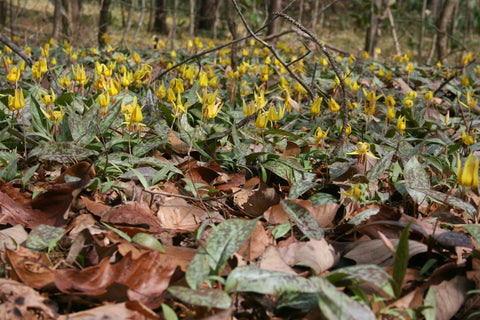About Trout Lily
Trout Lily (Erythronium americanum), also known as yellow trout lily or adder’s tongue, is a charming early-blooming woodland perennial native to eastern North America. Its delicate nodding yellow flowers and mottled, trout-patterned foliage give it a distinctive appearance, making it a favorite for gardeners who want to bring a natural woodland feel to shaded garden spaces.
Emerging in early spring, trout lily produces slender stems topped with one or two bright yellow, lily-shaped flowers that nod gracefully toward the ground. These blooms appear before the forest canopy fully develops, offering some of the first color of the season. The leaves are equally striking—long, lance-shaped, and speckled with shades of green and brown, resembling the markings of a trout, which inspired the plant’s common name.
Trout lily thrives in rich, well-drained soil with consistent moisture and prefers partial to full shade. It is ideal for woodland gardens, shaded borders, and naturalized areas under trees. Once established, trout lily spreads slowly via underground bulbs, forming large, naturalized colonies that carpet the forest floor with spring blooms. These colonies can take several years to establish, but become a stunning display when mature.
Trout Lily is a bulbous, perennial herb that usually grows to reach of 10-15 cm. It has simple, lanceolate leaves with a pale green color, and its blooming period is in early spring. The flowers are yellow with six petals that are typically curved backward, and each flower has a distinct lip that is white or yellowish-white with a dark purple or brownish spot in the center.
Trout Lily is relatively easy to grow and is often found in garden plantings in shady areas. It prefers partial shade and moist, well-drained soil. This plant is known for its ability to naturalize well and can spread to form dense colonies in the right conditions. It is also deer-resistant, making it a good choice for gardens where deer are a problem. Trout Lily pairs well with other spring ephemerals like bloodroot, Trilliums, spring beauties, and Dutchman’s breeches and naturalized areas.



